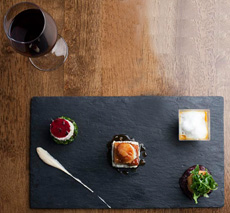TIP OF THE DAY: Slate Makes A Great Plate
|
|
Stylish restaurants are always looking for new plates and other dishes. After all, the presentation—the plate and the garnish—generates the “ooh!” factor when food is set before guests.
Sometimes, the eating receptacle is not part of a conventional place setting. In this photo, Chapter 40 restaurant repurposes a slate cheese board for an assorted hors d’oeuvre plate and miniature desserts. (And of course, they can be used to present cheese and other foods.) Slate is a fine-grained rock composed of layers ash, clay and other sediment, which were fused together millions of years ago. When quarried and cut by experts, they form smooth, flat sheets of stone that have long been used to create handsome roofs and floors. |
|
|
Slate is most often found in pale-to-dark grey shades, but in also exists naturally in pastel and brighter colors from copper and cyan to green, red and purple. Natural slate resists fading, abrasion and chemicals and is highly durable (but it’s highly porous, so floors and roofs require regular sealing). In recent years, slate has been made into cheese boards. Its subtle, natural beauty is a complement to food. You can also try to buy slate floor tiles as a more affordable solution. Flooring suppliers want to sell the whole floor and don’t embrace the sale of individual tiles. But if you have connections, or can get the store manager to order a dozen or two tiles (you can give the extras as gifts), you may be able to buy them for as little as $3 apiece. We went to a store that sells kitchen and bath tiles to contractors, in boxes of four for $20. While they didn’t have slate, we picked up a dozen beautiful granite tile squares in dark grey; then put felt stickers on the bottom to avoid scratching the table. We have our eyes on handsome dark red granite tiles as well. As with kitchen counters made from granite or marble walls and floors in a bathroom, they’re very easy to wash by hand. They’re heavier than conventional dinner plates, but gorgeous. |
||



